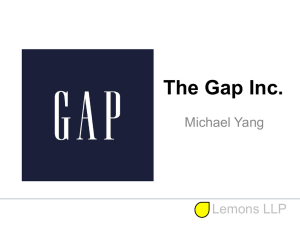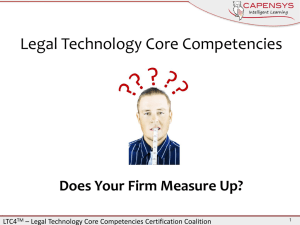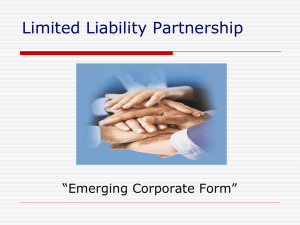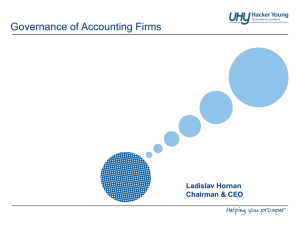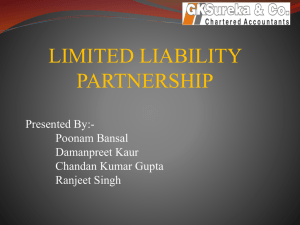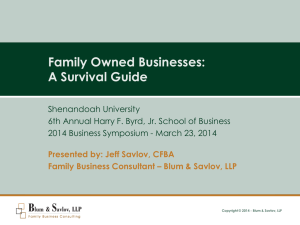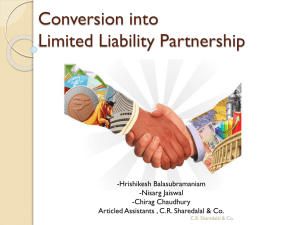Conversion of LLC into LLP by Nivedita Sarda
advertisement
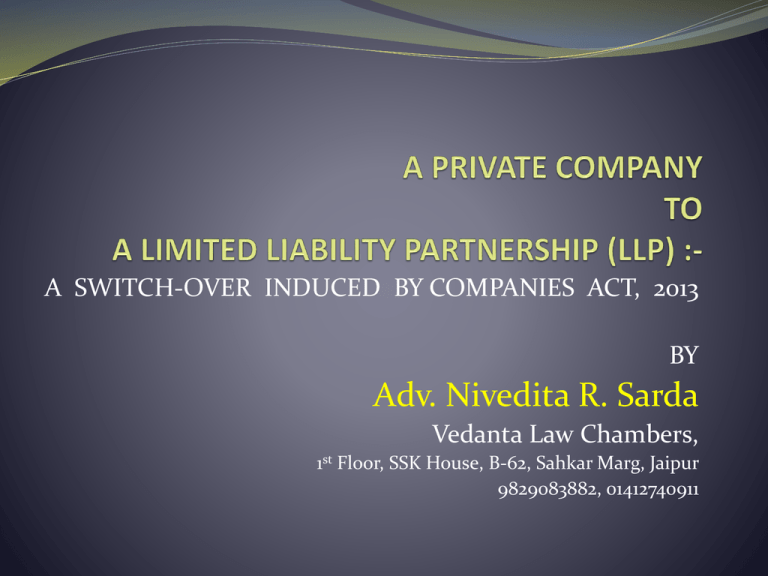
A SWITCH-OVER INDUCED BY COMPANIES ACT, 2013 BY Adv. Nivedita R. Sarda Vedanta Law Chambers, 1st Floor, SSK House, B-62, Sahkar Marg, Jaipur 9829083882, 01412740911 KEY CHANGES INTRODUCED BY THE 2013 ACT CHANGE IN CONCEPTS: A subsidiary company The concepts of ‘subsidiary’ and ‘holding company’ have also undergone changes under the 2013 Act, as the definition now requires a company to either have control over the board of directors of another company or have control over one-half of its total share capital (as opposed to equity share capital under the 1956 Act), whether directly or through another subsidiary, in order to qualify as its holding company. ‘Associate’ and ‘related party The 2013 Act has expanded the scope of ‘related party’ to include, in relation to a company, its key managerial personnel (“KMP”, being the CEO, CFO, company secretary, whole-time director and other prescribed officers) and their relatives, a public company in which a director or manager of the company holds more than 2% paid up capital, a person in accordance with whose instructions a director or manager of the company is accustomed to act, a body corporate whose board/managing director/manager is accustomed to act in accordance with instructions of a director or manager of the company, its holding company, subsidiary company, another subsidiary of the holding company and an ‘associate company’, among others. PENALTY Contravention of these provisions is punishable with imprisonment upto 5 years and/or fine upto the higher of INR 250 million and three times the amount of profits made by the defaulter. INTERCORPORATE LOANS, GUARANTEES & INVESTMENTS The restrictions with regard to inter-corporate loans, guarantees and investments have been extended, under the 2013 Act, to private companies and to such transactions between holding and subsidiary companies. While the 1956 Act enabled the board of directors to provide a guarantee in excess of the specified thresholds subject to shareholder ratification, the 2013 Act does not provide for the same. BORROWINGS AND DISPOSAL The earlier section 293 and the new section 180 pertained to powers of the Board of Directors which can be exercised only at a general meeting by way of special resolution to be passed for the purpose. Section 293(1)(d) pertained to borrowing powers of the companies i.e. the amount upto which the companies could borrow was laid down in the special resolution which was approved by the members in the general meeting. Companies are allowed to borrow any sums of monies upto the paid up share capital and free reserves of the company. Any borrowal in excess of the combination of these two limits i.e. paid up share capital and free reserves required approval of the members in the general meeting by way of special resolution. Typically companies passed an omnibus resolution securing approval for Rs.X amount which was way above the paid up share capital and free reserves of the company but sufficient for the purposes of the company. EXCESSIVE REGULATION ON COMPANIES A private company is now required to comply with all fund raising restrictions applicable to public companies such as those pertaining to private placement, rights issue, preferential allotment and issuance of shares with differential rights. The 2013 Act also mandates obtaining of shareholder approval for lease or disposal of an undertaking or its substantial part or for borrowings in excess of specified thresholds and for inter-corporate loans and investments. Private subsidiaries of public companies As per the definition of ‘public company’ under the 2013 Act, a private subsidiary of a company other than a private company, would be deemed to be a public company, even if the company contains the restrictions applicable to private companies in its Articles of Association. Therefore, a private subsidiary of a public company would also have to comply with provisions applicable to public companies PROBLEMS POSED TO THE PRIVATE COMPANIES DUE TO THE CHANGES LOAN TO DIRECTORS (sec185) A company can however give loan or give guarantee or provide security for the due repayment of any loan if it is in the ordinary course of its business. The rate of interest shall not be less than the rate of interest provided by RBI. Penal consequences for contravention of sec 185 The company shall be punishable with fine which shall not be less than Rs.5 lacs may extend to Rs.25 lacs. The person to whom loan etc. is be given shall be punishable with imprisonment which may extend to 6 months or with fine which shall not be less than Rs. 5 lacs may extend to Rs. 25 lacs or both. BORROWING POWERS According to sec 180(1)(c) of Companies Act, 2013 the Board of Directors of a company shall exercise the following powers only with the consent of the company by a special resolution, namely:— to borrow money, where the money to be borrowed, together with the money already borrowed by the company will exceed aggregate of its paid-up share capital and free reserves, apart from temporary loans obtained from the company’s bankers in the ordinary course of business: Provided that the acceptance by a banking company, in the ordinary course of its business, of deposits of money from the public, repayable on demand or otherwise, and withdrawable by cheque, draft, order or otherwise, shall not be deemed to be a borrowing of monies by the banking company within the meaning of this clause. It implies that it has become necessary for private companies to obtain approval of their members by way of special resolution passed at the general meeting that the company is allowed to borrow monies in excess of the paid up share capital and free reserves of the company, specifying thereby the maximum amount upto which monies could be borrowed by the company SWITCH-OVER Companies Act, 2013 has brought massive changes for private companies as barring a very few, all the exemptions which were available to private companies under the Companies Act, 1956 have been withdrawn in the Companies Act, 2013. This problem has brought a fresh and relaxed model of “LLP” into the scenario. WHAT IS A “LLP”? A Limited Liability Partnership is a hybrid between a company and a partnership that, as the name suggests, provides the benefits of limited liability and allows its members the flexibility of organizing their internal structure as a partnership based on a mutually arrived agreement. ADVANTAGES OF LIMITED LIABILITY PARTNERSHIP(LLP) In a nutshell, the Limited Liability Partnership has the following advantages: It provides limited liability to its partners. Though personal Liability arises in case of wrongful acts or omissions, a partner is not personally liable for such acts or omissions of other partner. LLP Business Structure also has the advantage of Internal Flexibility. As in traditional partnership, the internal structure of LLP can be organized as per mutual agreement. The requirements as to Board Meetings, Resolutions, Annual meetings, etc. are not there in case of LLP. There is less paperwork in case of LLPs, even the formation of a partnership agreement is not mandatory; the Act provides for default provisions in its Schedule I. The filing requirements are also less as compared to a company. Since LLP is a separate legal entity, its existence is not offered by the entry or exit of partners. HOW IS THE SWITCH-OVER BENEFICIAL? 1. TAXATION 2. NO AUDIT REQUIREMENT 3. AUTOMATIC TRANSFER 4. NO CAPITAL GAIN TAX 5. NO LIMIT ON NUMBER OF PARTNERS 6. MINIMAL COMPLIANCE LEVEL AND COST EFFECTIVE MODEL 7. CONTINUATION OF BRAND VALUE TAXATION REQUIREMENT OF AUDIT 1. Only the Limited Liability Partnership whose contribution exceed Rs. 25 Lakh or the Limited Liability Partnership whose turnover exceed Rs. 40 Lakh are required to annually get their accounts audited by any Chartered Accountant in practice. 2. Limited Liability Partnerships who are exempted from mandatory audit may also get their accounts audited as per the Limited Liability Partnership Rules 2009. 3. In case if the partners do not decide for the audit of the accounts of the LLP a statement to be included in the Statement of Account and Solvency by the partners to the effect that the partners acknowledge their responsibilities for complying with the requirements of the Act and the Rules with respect to preparation of books of account and a certificate. This certificate to be filed with the Registrar of Companies, LLP along with e Form 8. AUTOMATIC TRANSFER All the assets and liabilities of the company immediately before the conversion become assets and liabilities of the LLP. NO LIMIT ON NUMBER OF PARTNERS Unlike Private Limited Companies whose number of shareholders are limited to 50, an LLP can have unlimited number of partners. MINIMAL COMPLIANCE LEVEL & COST EFFECTIVE MODEL 1. Many of the privileges and exemptions currently available to private companies in the Companies Act 1956 stand withdrawn in Companies Act 2013. 2. Stricter compliance and disclosure regime for private companies under the Companies Act 2013. 3. This would require revamping and scaling up internal processes by the private companies. CONTINUATION OF BRAND VALUE The goodwill of the company and its brand value is kept intact and continues to enjoy the previous success story with legal recognition. DISADVANTAGE Consideration Ownership Restrictions Transferability Insurance Stamp duty on conversion According to the Indian Stamp Act 1899 stamp duty is applicable for Limited Liability Partnership Agreements under the respective State Stamps Acts on the basis of contribution. A private company can look forward to convert into more flexible form of Limited Liability Partnership without paying stamp duty to state governments. The government intends to allow these entities to vest the ownership of their assets with a newly formed LLP without executing a deal of transfer these assets. To remove the requirement of transfer of assets through conveyance or instrument which attracts stamp duty, the government has introduced a special provision in the LLP bill for vesting of assets on the LLP at the time of its registration. Inbound and Outbound FDI is subject to FEMA regulations LLP with FDI will not be eligible to make downstream investment Not permitted in Agricultural, plantation, Print media, real estate FDI in LLP under automatic route Is not allowed. Inbound Investment FDI permitted in Sectors where 100% FDI allowed Through Automatic route FDI allowed Only Through government route FDI policy for LLP Announced in April 2012 Foreign Institutional Investors cannot Invest in LLP Conversion of Co. With FDI into LLP, Allowed With prior approval Of FIPB/ Government. Foreign Capital Participation by way Of debit to NRE / FCNR account Foreign Venture Capital Investors Cannot invest in LLP Inbound Investment Foreign Capital Participation by way Of cash, through Normal banking channels LLP’s cannot avail External Commercial Borrowing Co. registered In India can nominate Designated partner In LLP having FDI LLP is not permitted to invest outside India under automatic route Outbound Investment No guidelines are framed So far LLP can make investment With prior approval of RBI Service tax, Sales Tax and registration Service Tax For the purpose of Service Tax, an LLP will be treated as partnership firm only. Service Tax rules, 1994 has been amended by the Service Tax (Amendment) Rules, 2012 to consider LLP as a partnership firm. Even when the word “body corporate” is used it will not include LLP’s despite of its legal status being a body corporate. Accordingly, Partial reverse charge is also not applicable to an LLP. Rate of service Tax- 12.36% Due date for payment: OFLINE- 5th day of the following quarter in which payment is received. ONLINE- 6th day of the following quarter in which payment is received. Sales Tax/ VAT Under Sales Tax, LLP is treated as Body Corporate. The definition of “Dealer” under Central Sales Act, 1956 includes body corporate also. There is no dissimilarity in partnership firm, body corporate etc with regard to payment, return, audit etc under sales act. Provisions for different dealers are distinguished based on the volume/ size or turnover of the dealer and not on the basis of the status of the dealer. Procedure to Convert Limited Liability Company into LLP Obtain DPIN for the designated Partner and DIN If registrar is satisfied that application is in order, he will register the conversion. Registrar will issue the certificate of registration on conversion of the private limited company into LLP in Form 19 of the LLP Rules & forms 2008 Application for allotment of DPIN to be made online in E-form 7 (Procedure in Annexure 1) Application for conversion has to be made in Eform 18 among with attachment. Annexure 2 LLP shall within 15 days from registration, inform the concerned ROC about such conversion in Form 14 of the LLP rules & Forms 2008 (annexure 3) Shareholders being directors who already possessed DIN, then the same can be used in LLP. Application made in E form 1. Applicable fees has to be paid by credit card. Decide the name with which LLP is to be incorporated. Registrar will approve the name, if the name is not undesirable or identical. LLP shall ensure that for 12 months, commencing not later than 14 days after date of registration, every correspondence shall bear name and registration No. of company so converted. Annexures 2 Attachments with form 18: Statement of shareholders (may be attached in a tabular form) Incorporation Document & Statement in Form 2 filed electronically. Statement of Assets and Liabilities of the company duly certified as true and correct by the Chartered Accountant in practice. List of all the creditors along with their consent to the conversion (may be given in the form of a tabular statement). Approval of the governing council (In case of professional private limited companies) NOC from Income Tax authorities. Approval from any other body/authority as may be required. Particulars of pending proceedings from any court/Tribunal etc. Rejection letter of Registrar of any earlier application for conversion. Particulars of convictions, rulings, orders, judgement of Courts in favour or against the private limited company which are subsisting. Other optional attachments as may be required. Income Tax issues on conversion- Capital gain Section 72(6A)transfer of assets on conversion to a LLP exempt, under Section 47(xiiib) of the LLP Act subject to – All the assets and liabilities of the company immediately before the conversion become the assets and liabilities of the LLP; 2. All the shareholders of the company immediately before the conversion become the partners of the LLP and their capital contribution and profit sharing ratio in the LLP are in the same proportion as their shareholding in the company on the date of conversion; 3. The shareholders of the company do not receive any consideration or benefit, directly or indirectly, in any form or manner, other than by way of share in profit and capital contribution in the LLP; 1. The aggregate of the profit sharing ratio of the shareholders of the company in the LLP shall not be less than fifty percent at any time during the period of five years from the date of conversion; 2. The total sales, turnover or gross receipts in the business of the company in any of the three previous years preceding the previous year in which the conversion takes place does not exceed sixty lakh rupees; and 3. No amount is paid, either directly or indirectly, to any partner out of balance of accumulated profit standing in the accounts of the company on the date of conversion for a period of three years from the date of conversion. 1. Provisions on breach of Rs. 60 lakh condition VIEW 1- Slump Sale from private Limited Company The difference between consideration received for the transfer and networth of the business transferred is treated as capital gains. The consideration will be equal to networth and hence no gain is likely to accrue, except in case of transfer of land or buildings where Section 50C of the Act, will kick in. NOTE: 1. Calculation of net worth- Aggregate vale of assets of the business transferred – Book value of liabilities. 2. Value of assets: Depreciable assets- Written down value, Other assets- Book value 3. Nature of Capital gain- Long term if held for more than 36 months otherwise short. 4. Section 50C- Substitution of consideration for stamp duty value View 2- No Transfer but only change in form to LLP No capital gain would arise in LLP on account of automatic Vesting of assets/ liabilities in LLP. On account of assets being transferred at book value And shareholders become partners and receive profits in line with profit sharing ratio No actual consideration payable to company/ shareholders on account of conversion View 3- Dissolution of Company and Formation Of New LLP Shareholders taxed on shares transferred on the basis of dissolution of Company on conversion Taxable value determined according to section 46Amount of accumulated profits treated as deemed dividend under section 2(22)(c). The same is exempt, Provided LLP paying DDT @ 16.223%. Market value of assets distributed in excess of accumulaTed profits treated as full value of consideration, subject to Capital gain tax under section 46. Carry forward of business loss/ unabsorbed depreciation Carried forward of business losses or unabsorbed depreciation of a company which is converted into LLP can be carried forward in the hands of LLP and set off against the profit of LLP. Section 72(6A) – the reference is to satisfaction of conditions u/s 47(xiiib)- benefit of carry forward will only be available if condition of Section 72(6A) are satisfied. The spirit is that when company is converted to LLP there is no transfer and hence the benefit to the company be permitted in the hands of LLP. Whether a view can be taken that de hors the provisions of Section 47(xiiib), there is no transfer and hence the benefit of carry forward be allowed even if the conditions of Section 47(xiiib) are not satisfied. Relevant provisions of Income Tax Act, 1961 No. Section Subject Effective date 1. Section 32(1) 5th Proviso Depreciation in the year of conversion. Prorate allocation between the company and LLP A.Y. 2011-2012 2. Section 35 DDA (4A) Amortization of expenditure incurred on Voluntary Retirement Scheme- LLP eligible to claim deduction for balance period A.Y. 2011-2012 3. Section 43(1) Explanation 13(b)(iii) Actual Cost- where deduction is allowed u/s 35ADcost will be Nil A.Y. 2011-2012 4. Section 43(6) Explanation 2C Written down value- cost in the hands of LLP will be cost in the hands of company. A.Y. 2011-2012 5. Section 49(1)(iii)(e) Cost of previous owner- cost in the hands of LLP will be cost in the hands of company. A.Y. 1999-2000 6. Section 49 (2AAA) Rights of partner in LLP- Cost of acquisition A.Y. 2011-2012 7. Section 72A (6A) Carry forward of business loss and unabsorbed depreciation. A.Y. 2011-2012 8. Section 115JAAA(7) Carry forward of MAT credit of company not available to LLP. A.Y. 2011-2012 Taxability of LLP As per the Budget 2009-10, LLP will be treated as Partnership firms for the purpose of Income Tax and will be taxed like a partnership firm. Tax rate: 30% flat tax rate + 3% education cess No Dividend Distribution Tax ITR- 5 is applicable Eligibility (section 184): In order for Limited Liability Partnership to be assessed as firm as Income Tax Act, it has to satisfy the following criteria The LLP is evidenced by an instrument i.e. there is a written LLP Agreement. The individual shares of the partners are very clearly specified in the deed. A certified copy of LLP Agreement must accompany the return of income of the LLP of the previous year in which the partnership was formed. If during a previous year, a change takes place in the constitution of the LLP or in the profit sharing ratio of the partners, a certified copy of the revised LLP Agreement shall be submitted along with the return of income of the previous years in question. There should not be any failure on the part of the LLP while attending to notices given by the Income Tax Officer for completion of the assessment of the LLP. House open for Queries
